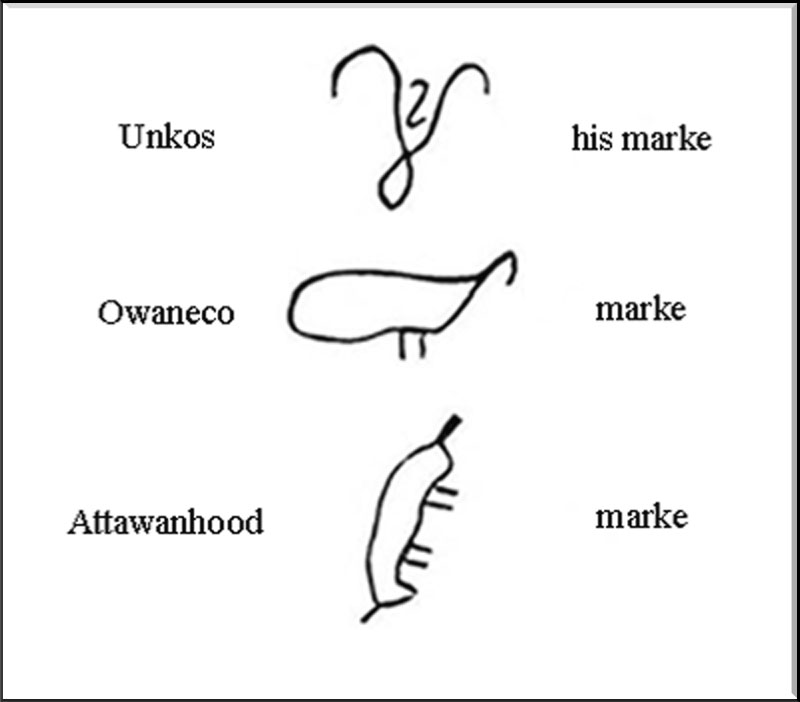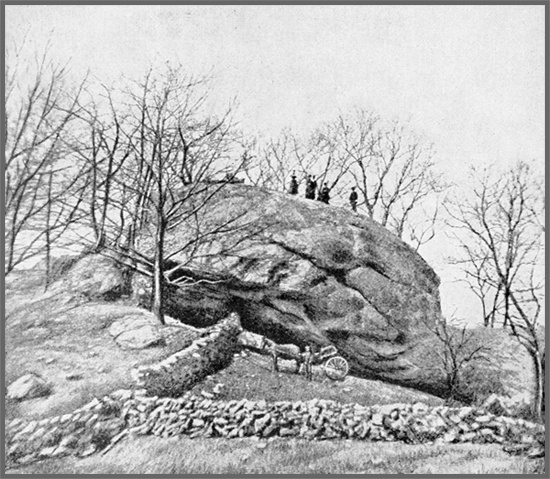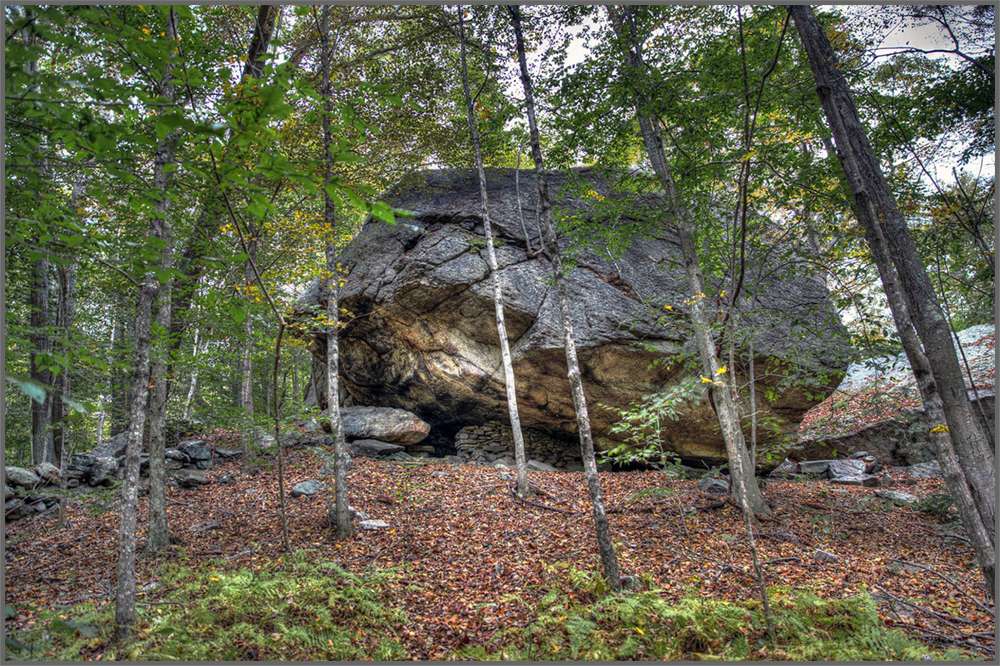Choose a Mohegan Placemark
1588-1683 Uncas
The exact dates of the birth and death of Uncas are unknown, however, his legacy and impact, on what is now southeastern Connecticut, is well documented. Uncas was married to the daughter of the principal Pequot sachem Tatobem. They had two sons, Owaneco, (Uncas’ father was also named Owaneco), and Attawanhood. Uncas’ brother was Waweekus, for whom Waweekus Hill in Norwich is named.
Uncas lived in an era of dramatic change in southeastern Connecticut. Native America was in the early stage of being colonized by Europeans from Holland and England. Both Native Americans and Europeans needed strong, highly respected leaders, such as Uncas, who could protect his own people’s interest while satisfying the demands of coming certain change.
At a young age Uncas became conversant in his native language, English and possibly Dutch. This knowledge helped him to understand the foreign ways of the Europeans. Upon becoming Sachem of the Mohegan, after much tribulation, he served as the primary intermediary between the Mohegan and the Europeans.
Major John Mason, the Commissioner of the United Colonies, was a friend of Uncas and had been called on to negotiate several quarrels between Uncas and other Native Americans. In 1659, Uncas and his sons, Owaneco and Atttawanhood, sold a large tract of land, the “Nine Mile Square”, to the European colonists in Connecticut. Soon after the purchase Major Mason, Reverend John Fitch, and 33 others moved to Norwich and became the founding fathers of Norwich.
Info Source 1 is a modern, scholarly biography of Uncas. Info Source 2 contains a nice overview of Uncas’ relationships with his family, the other Native Americans tribes, and the English.
Acknowledgements
The complete list of sources may be found by clicking the “Bibliography” button, and, then typing “Uncas” in the SEARCH box.
1635 Uncas Becomes Chief
Most people believe that American Natives chased their food source, mainly the Woolly Mammoth, through the Bering Straits Land Bridge and that our people then came across and down into what are now the Great Lakes and the Hudson River Valley. This group of Monheags ended up along the Quinatucquet River, which later became known as the Connecticut River in what is now Connecticut. The Dutch called them the Pequins, then the French changed their name to Pequods and the English changed it to Pequot’s.
Later when the English showed up on the Quinatucquet and Pequot Rivers, Sachem Wopigwooit was the leader of the tribe. After his passing, the people then chose Sasscus as leader, instead of Uncas who should have rightfully been Sachem, hoping that he would force the English back into the ocean. Sasscus like the Niantic’s and the Narragansett’s hated the English and was at war with them constantly.
War chief Uncas, who was Sasscus’s son-in-law, tried to reason with Sasscus and the people, but they would not listen to him. So Uncas took all who wished to go with him, across the Pequot River, to the Cauchegan village.
Uncas gave them back their old name, Monheags, and became their Sachem.
Acknowledgements
Sachem Walkingfox
wpclipart

1643 Indian Leap at Yantic Falls
On September 17th, 1643, The Battle of the Great Plain brought Narragansett and Mohegan warriors to Yantic Falls, a popular Mohegan fishing and gathering place. Narragansett and Mohegan runners chased one another to a chasm that overlooks the Yantic River.
Uncas sent his fastest runner, Tantaquidgeon, to apprehend the Narragansett Sachem Miantonomo, who was weighed down by a gift of English armor.
According to tribal tradition only a Sachem can capture another Sachem. Abiding by this tribal protocol, Tantaquidgeon thus held Miantonomo until Uncas’s arrival. Uncas made the long jump across the chasm, which was at that time narrower before modern-day erosion. Some warriors failed to reach the other side, falling to their deaths on the rocks below.
Acknowledgements
WalkNorwich.org
Public Domain
1659 DEED TO NORWICH
In May of 1659, the residents of Saybrook petitioned the General Court of Connecticut for permission to create a settlement in the area that is now known as Norwich. On May 20, 1659 the Court approved and consented to “what is desired by ye petitioners, respecting the Mohegin, provided yt within ye space of three yeares they doe effect a plantation in ye place propounded”.
The next month on June 6, 1659 the deed for the land was was signed by Uncas and his sons for the price of £70 British pounds, (Approximately $11,000 in today’s dollars). After an initial survey of the land was completed in the fall of 1659 a few of the settlers removed from Saybrook to the new plantation. However, no goods were moved until the spring of 1660.

The image on the left illustrates the signatures (marks) of the Mohegan signers on the deed to Norwich.
The following is a transcript of the deed to Norwich, signed by Uncas and others.
"Know all men that Onkos, Owaneco, Attawanhood, Indians of Mohegan, have Bargained, sold, and passed over, and doe by these presents sell and pass over unto the Towne and Inhabitants of Norwich nine miles square of land lying and being at Moheagan and the parts thereunto adjoyneing, with all ponds, rivers, woods, quarries, mines, with all royalties, privileges, and appurtenances thereunto belonging, to themthe said inhabitants of Norwich, theire heirs and successors forever-the said lands are to be bounded as followeth, (viz.) to the southward on the west side of the Great River, ye line is to begin at the brooke falling into the head of Trading Cove, and soe to run west norwest seven miles-fron thence the line to run nor north east nine miles, and on the East side the afores'd river to the southward the line is to joyne with New London bounds as soe from thence the line is to run nor noreast nine miles and from thence to run nor norwest nine miles to meet with the western line.-In consideration whereof the sd Onkos, Owaneco and Attawanhood doe acknowledge to have received of the parties aforesd the full and juste sum of seventy pounds and doe promise and egage ourselves, heirs and successors, to warrant the sd bargin and sale to the aforsd parties, their heirs and successors, and them to defend from all claims and molestations from any whatsoever.-In witness whereof we have hereunto set to our hands this 6th of June, Anno 1659."
Acknowledgements
“History of Norwich, Connecticut: From Its Possession From the Indians, to the Year 1866”, page 57, by Frances Manwaring Caulkins
“History of Norwich, Connecticut: From Its Possession From the Indians, to the Year 1866”, page 58, by Frances Manwaring Caulkins
1723-1792 Samson Occum
Work in Progress
Acknowledgements
1828-1916 Emma Fielding Baker
Work in Progress
Acknowledgements

1833 Andrew Jackson Visits Norwich
During the summer of 1833, President Andrew Jackson
decided to tour a portion of the Eastern states. Accompanying him would be the Vice President Martin Van Buren and several other dignitaries.
About that same time, many citizens in Norwich had been anxious to erect some sort of memorial of respect for the Mohegan Sachem, Uncas. As word reached Norwich regarding the president’s tour, residents decided to make an effort to connect President Jackson’s travel plan with a ceremony featuring the president laying the cornerstone of a monument honoring Uncas.
On June 24, 1833 the presidential party came from Hartford by land, arriving by the Essex Turnpike in open coaches, guided by a colorful and brilliant escort of cavalry that had left Norwich to meet the party. At the cemetery they were greeted by a large segment of local citizens, more than one military company, groups of children with appropriate banners and a number of Mohegan Indians.
President Jackson moved the foundation-stone into its place. One reporter later wrote that it was “a token of respect from the modern warrior to the ancient warrior.” (Uncas had died some 149 years previously, in 1684).
The granite column seen on the site today was dedicated in 1842.
Acknowledgements
The Bulletin 04/16/2018
Bureau of Engraving and Printing

Cochegan Rock
This photo was taken of Cochegan Rock in 1890. The site has been used by many people for many different purposes over the years.
The following is a quote from the Mohegan Sachem Walking Fox :
“Cochegan/Cauchegan Rock has been over looked for many years now and I like it that way. Cauchegan rock is the largest rock in Mohegan land. The unique setting of the rock, was the main reason that it was used so often as a meeting place by Uncas and his followers. In the spring and for most of the summer, the tribe used it and the land around it, for one of their many villages. Often times, the trees would be used where they stood to form long and roundhouses.”

“The villages were surrounded by fresh water for drinking, gardening, washing, etc., while, the nearby Pequot River provided an abundant supply of fish and clams. My Grandfather told me that the tribe would often put tables and chairs on top of Cauchegan Rock when they held their meetings. This would also allow them to see anyone coming towards them from great distances.”
“In the colder weather, the tribe would use the rocks and trees in the area to shelter them from the winds. The warmer weather was used for gardening. The first Pauwas of the new season would begin at the rock with fellowshipping, before going on to the Great River to Pauwas with other tribes.”
Acknowledgements
Sachem Walkingfox
Popular Science Monthly, Volume 37D210, page 198
1907 Buffalo Bill Visits Norwich
The cornerstone of the Uncas monument had been laid on June 24, 1833, with President Andrew Jackson and Vice President Martin Van Buren attending the ceremony.
Acknowledgements
ConnecticutHistory.org
The Bulletin 04/08/2017
1931-Present Tantaquidgeon Museum
Work in progress
Work in progress
Acknowledgements
“Historically Speaking: Eastern Connecticut Boasts Many Firsts” (07/10/2008), by Richard Curland